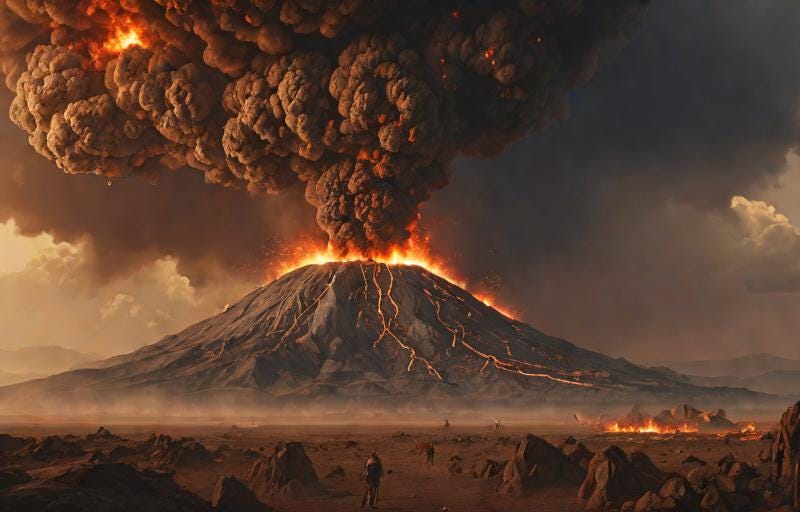A favorite, oft-enjoyable pastime when preppers gather for friendly conversation is to discuss 'the end of the world as we know it.' Not so much how to survive and thrive in such a world, per se, for those deliberations are of a more serious nature. No, the enjoyment comes from spirited banter over how it might actually transpire, or - in other words - what specific event will set it off.
There are many fascinating theories out here, each one being unique and (in most cases) plausible. Everything from major earthquakes to solar flares to government takeovers to pandemics to EMPs (a personal favorite of mine) are discussed and dissected. In every group, however, there will usually be one prepper who mentions the Yellowstone Caldera, and when that happens a quiet moment oft descends on the discussion.
For those unaware, Yellowstone National Park is one massive, festering volcano. It is classified on the Volcanic Explosivity Index (VEI) as a category 8, also known as a 'super volcano.' Many scientists consider its impending eruption to be an 'extinction level event' (ELE) for the species homo sapiens, and it erupts on a fairly regular schedule - once every 640,000 years or so.
Oh, did I mention 'impending?" Yeah, the next Yellowstone blowout is a few thousand years overdue.
Thus it is understandable why a Yellowstone eruption commands a certain respect when being discussed. Something should be considered, however, when analyzing this scenario: Is it even possible to prepare for an ELE, and if it is... would you really want to be around for the life which follows it?
The "Extinction' part of ELE is very much a non-starter - it means we are done. Crispy-toast done. The damage a major Yellowstone eruption would do to this planet is incalculable, and it is very likely that even the richest, most knowledgeable prepper in the world would be incapable of preparing for such an event.
The ugly truth is when Yellowstone erupts life on this planet will be irreversibly rewritten. Whatever springs up to replace that which has been destroyed will be very different from our current world, so different that it may be hostile toward whatever pockets of humanity do somehow manage to survive. We may eventually find ourselves in a different link on the food chain - a link where we would have no chance of survival.
While this is a sad fact, we shouldn't worry ourselves too much over it; after all, if we are all gone there will not be anyone around to morn over it. Besides, in fretting over Yellowstone we lose sight of the volcanos we can survive... the ones about which we should be talking, for which we should be preparing.
As the VEI scale gives us a category 8, it also provides us with a category 7. These volcanos are called Ultra-Plinian, and while the name doesn't have the punch of 'super' volcano they are real, they are deadly, and - most importantly - they are survivable.
Ultra-Plinian volcanoes are basically scaled-back versions of their more terrifying super-cousins. While a major eruption from one of these will not completely end our time on Earth, it would certainly challenge the best of preppers; imagine then, how one would affect those unprepared?
The 1815 eruption of Mount Tambora was a VEI 7 event. Beginning with a massive blast on April 10th of that year, it, was followed by between six months and three years of increased activity. The eruption lowered global temperatures, leading to ‘global cooling’ and worldwide harvest failures. 1815 is oft referred to as the ‘Year Without a Summer.’
This is not 1815, however; our world is very different today. As such, an individual does not have to stretch their imagination too far to ascertain how an eruption of this magnitude would play out in the now. Global crop failures, on a planet with nearly eight billion people? Civil unrest facilitated by barren food supplies? Rampant disease due to mass-death by starvation? It makes our approaching food shortages and previous riots and the recent ‘pandemic’ seem almost quaint in comparison. Indeed, it would genuinely be a ‘worst case scenario’... without the extinction, of course.
This is why I have started giving Yellowstone a pass while keeping a sharper eye on those VEI 7 volcanos instead; there is a long list of potential hotspots, with many of them experiencing recent activity. They are also scattered all over the planet, with one - California's Long Valley Caldera - being situated right here in our own proverbial backyard.
Therefore the next time you're sitting down to enjoy some food, beverages, and dialogue with your fellow preppers and the conversion turns to Yellowstone, make sure to show the 'sevens' some love and respect. It is not only good prepper sense, but the exchange which follows could spark new ideas and thoughtful preparations. This, in turn, may save lives in the future if - by likely chance - another Tambora should transpire.
[Note: A variation of this article was first published in 2013; I wanted to feature it as my first serious post here, thus I have done so with edits]




